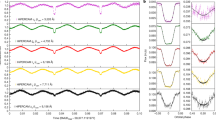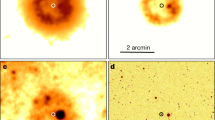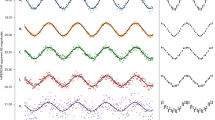Abstract
White dwarfs are dense, cooling stellar embers consisting mostly of carbon and oxygen1, or oxygen and neon (with a few per cent carbon) at higher initial stellar masses2. These stellar cores are enveloped by a shell of helium, which in turn, is usually surrounded by a layer of hydrogen, generally prohibiting direct observation of the interior composition. However, carbon is observed at the surface of a sizeable fraction of white dwarfs3,4, sometimes with traces of oxygen, and is thought to be dredged up from the core by a deep helium convection zone5,6. In these objects, only traces of hydrogen are found7,8, as large masses of hydrogen are predicted to inhibit hydrogen–helium convective mixing within the envelope9. We report the identification of WD J055134.612+413531.09, an ultra-massive (1.14 solar masses (M⊙)) white dwarf with a unique carbon–hydrogen mixed atmosphere (atomic ratio C∕H = 0.15). Our analysis of the envelope and interior indicates that the total hydrogen and helium mass fractions must be several orders of magnitude lower than predictions of single-star evolution10: less than 10−9.5 and 10−7.0, respectively. Due to the fast kinematics (129 ± 5 km s−1 relative to the local standard of rest), large mass and peculiar envelope composition, we argue that WD J0551+4135 is consistent with formation from the merger of two white dwarfs in a tight binary system11,12,13,14.
This is a preview of subscription content, access via your institution
Access options
Access Nature and 54 other Nature Portfolio journals
Get Nature+, our best-value online-access subscription
$29.99 / 30 days
cancel any time
Subscribe to this journal
Receive 12 digital issues and online access to articles
$119.00 per year
only $9.92 per issue
Buy this article
- Purchase on Springer Link
- Instant access to full article PDF
Prices may be subject to local taxes which are calculated during checkout




Similar content being viewed by others
Data availability
The spectra of WD J0551+4135 are provided as Supplementary Data 1, the best-fitting model spectrum as Supplementary Data 2 and the lightcurves as Supplementary Data 3.
Code availability
The Koester model atmosphere and envelope codes, as well as the lpcode/lp-pul evolutionary/pulsation codes, are not made available. However, their associated references in the text can be consulted for further details.
References
Paczyński, B. Evolution of single stars. I. Stellar evolution from main sequence to white dwarf or carbon ignition. Acta Astron. 20, 47–58 (1970).
Camisassa, M. E. et al. The evolution of ultra-massive white dwarfs. Astron. Astrophys. 625, A87 (2019).
Hollands, M. A., Tremblay, P. E., Gänsicke, B. T., Gentile-Fusillo, N. P. & Toonen, S. The Gaia 20 pc white dwarf sample. Mon. Not. R. Astron. Soc. 480, 3942–3961 (2018).
Kepler, S. O. et al. White dwarf and subdwarf stars in the Sloan Digital Sky Survey Data Release 14. Mon. Not. R. Astron. Soc. 486, 2169–2183 (2019).
Koester, D., Weidemann, V. & Zeidler, E. M. Atmospheric parameters and carbon abundance of white dwarfs of spectral types C2 and DC. Astron. Astrophys. 116, 147–157 (1982).
Pelletier, C., Fontaine, G., Wesemael, F., Michaud, G. & Wegner, G. Carbon pollution in helium-rich white dwarf atmospheres: time-dependent calculations of the dredge-up process. Astrophys. J. 307, 242–252 (1986).
Coutu, S. et al. Analysis of helium-rich white dwarfs polluted by heavy elements in the Gaia era. Astrophys. J. 885, 74 (2019).
Koester, D. & Kepler, S. O. Carbon-rich (DQ) white dwarfs in the Sloan Digital Sky Survey. Astron. Astrophys. 628, A102 (2019).
Rolland, B., Bergeron, P. & Fontaine, G. On the spectral evolution of helium-atmosphere white dwarfs showing traces of hydrogen. Astrophys. J. 857, 56 (2018).
Iben, J. I. & Renzini, A. Asymptotic giant branch evolution and beyond. Annu. Rev. Astron. Astrophys. 21, 271–342 (1983).
Toonen, S., Nelemans, G. & Portegies Zwart, S. Supernova type Ia progenitors from merging double white dwarfs: using a new population synthesis model. Astron. Astrophys. 546, A70 (2012).
Shen, K. J., Bildsten, L., Kasen, D. & Quataert, E. The long-term evolution of double white dwarf mergers. Astrophys. J. 748, 35 (2012).
Cheng, S., Cummings, J. D. & Ménard, B. A cooling anomaly of high-mass white dwarfs. Astrophys. J. 886, 100 (2019).
Gvaramadze, V. V. et al. A massive white-dwarf merger product before final collapse. Nature 569, 684–687 (2019).
Gentile Fusillo, N. P. et al. A Gaia Data Release 2 catalogue of white dwarfs and a comparison with SDSS. Mon. Not. R. Astron. Soc. 482, 4570–4591 (2019).
Gaia Collaboration.et al. Gaia Data Release 2: summary of the contents and survey properties. Astron. Astrophys. 616, A1 (2018).
Chandrasekhar, S. The highly collapsed configurations of a stellar mass (second paper). Mon. Not. R. Astron. Soc. 95, 207–225 (1935).
Sion, E. M. et al. A proposed new white dwarf spectral classification system. Astrophys. J. 269, 253–257 (1983).
Althaus, L. G., García-Berro, E., Isern, J., Córsico, A. H. & Miller Bertolami, M. M. New phase diagrams for dense carbon–oxygen mixtures and white dwarf evolution. Astron. Astrophys. 537, A33 (2012).
Koester, D. Accretion and diffusion in white dwarfs: new diffusion timescales and applications to GD 362 and G 29-38. Astron. Astrophys. 498, 517–525 (2009).
Cunningham, T., Tremblay, P.-E., Freytag, B., Ludwig, H.-G. & Koester, D. Convective overshoot and macroscopic diffusion in pure-hydrogen-atmosphere white dwarfs. Mon. Not. R. Astron. Soc. 488, 2503–2522 (2019).
Cummings, J. D., Kalirai, J. S., Tremblay, P. E., Ramirez-Ruiz, E. & Choi, J. The white dwarf initial–final mass relation for progenitor stars from 0.85 to 7.5 M ⊙. Astrophys. J. 866, 21 (2018).
Tremblay, P. E. et al. 3D model atmospheres for extremely low-mass white dwarfs. Astrophys. J. 809, 148 (2015).
Curd, B. et al. Four new massive pulsating white dwarfs including an ultramassive DAV. Mon. Not. R. Astron. Soc. 468, 239–249 (2017).
Dufour, P., Liebert, J., Fontaine, G. & Behara, N. White dwarf stars with carbon atmospheres. Nature 450, 522–524 (2007).
Ferrario, L., Vennes, S., Wickramasinghe, D. T., Bailey, J. A. & Christian, D. J. EUVE J0317−855: a rapidly rotating, high-field magnetic white dwarf. Mon. Not. R. Astron. Soc. 292, 205–217 (1997).
Córsico, A. H. & Althaus, L. G. Asteroseismic inferences on GW Virginis variable stars in the frame of new PG 1159 evolutionary models. Astron. Astrophys. 454, 863–881 (2006).
De Gerónimo, F. C., Córsico, A. H., Althaus, L. G., Wachlin, F. C. & Camisassa, M. E. Pulsation properties of ultra-massive DA white dwarf stars with ONe cores. Astron. Astrophys. 621, A100 (2019).
Córsico, A. H., Althaus, L. G., Miller Bertolami, M. M. & Kepler, S. O. Pulsating white dwarfs: new insights. Astron. Astrophys. Rev. 27, 7 (2019).
Tanikawa, A. et al. Hydrodynamical evolution of merging carbon–oxygen white dwarfs: their pre-supernova structure and observational counterparts. Astrophys. J. 807, 40 (2015).
Currie, M. J. et al. Starlink Software in 2013. Astron. Soc. Pac. Conf. 485, 391–394 (2014).
Marsh, T. molly: 1D astronomical spectra analyzer. Astrophys. Source Code Libr. 1907.012 (2019).
Koester, D. White dwarf spectra and atmosphere models. Mem. Soc. Astron. Ital. 81, 921–931 (2010).
Gaia Collaboration et al. Gaia Data Release 2: observational Hertzsprung–Russell diagrams. Astron. Astrophys. 616, A10 (2018).
Chambers, K. C. et al. The Pan-STARRS1 surveys. Preprint at https://arxiv.org/abs/1612.05560 (2016).
Morrissey, P. et al. The calibration and data products of GALEX. Astrophys. J. Suppl. 173, 682–697 (2007).
Wall, R. E. et al. GALEX absolute calibration and extinction coefficients based on white dwarfs. Mon. Not. R. Astron. Soc. 489, 5046–5052 (2019).
Tremblay, P.-E., Ludwig, H.-G., Steffen, M. & Freytag, B. Spectroscopic analysis of DA white dwarfs with 3D model atmospheres. Astron. Astrophys. 559, A104 (2013).
Fontaine, G., Brassard, P. & Bergeron, P. The potential of white dwarf cosmochronology. Publ. Astron. Soc. Pac. 113, 409–435 (2001).
Siess, L. Evolution of massive AGB stars. II. Model properties at non-solar metallicity and the fate of super-AGB stars. Astron. Astrophys. 476, 893–909 (2007).
Siess, L. Evolution of massive AGB stars. III. The thermally pulsing super-AGB phase. Astron. Astrophys. 512, A10 (2010).
Paquette, C., Pelletier, C., Fontaine, G. & Michaud, G. Diffusion coefficients for stellar plasmas. Astrophys. J. Suppl. 61, 177–195 (1986).
Paquette, C., Pelletier, C., Fontaine, G. & Michaud, G. Diffusion in white dwarfs—new results and comparative study. Astrophys. J. Suppl. 61, 197–217 (1986).
Iben, J. I. & MacDonald, J. The effects of diffusion due to gravity and due to composition gradients on the rate of hydrogen burning in a cooling degenerate dwarf. I. The case of a thick helium buffer layer. Astrophys. J. 296, 540–553 (1985).
Spiegel, E. A. A generalization of the mixing-length theory of turbulent convection. Astrophys. J. 138, 216–225 (1963).
Zahn, J.-P. Convective penetration in stellar interiors. Astron. Astrophys. 252, 179–188 (1991).
Tremblay, P. E. et al. Calibration of the mixing-length theory for convective white dwarf envelopes. Astrophys. J. 799, 142 (2015).
Kupka, F., Zaussinger, F. & Montgomery, M. H. Mixing and overshooting in surface convection zones of DA white dwarfs: first results from ANTARES. Mon. Not. R. Astron. Soc. 474, 4660–4671 (2018).
Cukanovaite, E. et al. Calibration of the mixing-length theory for structures of helium-dominated atmosphere white dwarfs. Mon. Not. R. Astron. Soc. 490, 1010–1025 (2019).
Dhillon, V. S. et al. ULTRASPEC: a high-speed imaging photometer on the 2.4-m Thai National Telescope. Mon. Not. R. Astron. Soc. 444, 4009–4021 (2014).
Chote, P. et al. Puoko-nui: a flexible high-speed photometric system. Mon. Not. R. Astron. Soc. 440, 1490–1497 (2014).
Tremblay, P.-E. et al. Core crystallization and pile-up in the cooling sequence of evolving white dwarfs. Nature 565, 202–205 (2019).
Acknowledgements
M.A.H. acknowledges discussions on the nature of WD J0551+4135 with P. Bergeron and A. Karakas, and with M.-T. Belmonte on the quality of experimental atomic data. The research leading to these results has received funding from the European Research Council under the European Union’s Horizon 2020 research and innovation programme no. 677706 (WD3D). A.A. acknowledges support from the Faculty of Science, Naresuan University (grant no. R2562E029). V.S.D. and ULTRASPEC are funded by the STFC. This work presents results from the European Space Agency (ESA) space mission Gaia. Gaia data are being processed by the Gaia Data Processing and Analysis Consortium (DPAC). Funding for the DPAC is provided by national institutions, in particular the institutions participating in the Gaia MultiLateral Agreement (MLA). The Gaia mission website is https://www.cosmos.esa.int/gaia and the Gaia archive website is https://archives.esac.esa.int/gaia. The William Herschel Telescope is operated on the island of La Palma by the Isaac Newton Group of Telescopes in the Spanish Observatorio del Roque de los Muchachos of the Instituto de Astrofísica de Canarias. This work is based on observations made with ULTRASPEC at the Thai National Observatory, which is operated by the National Astronomical Research Institute of Thailand (Public Organization).
Author information
Authors and Affiliations
Contributions
M.A.H., P.-E.T. and B.T.G. led the project, including the interpretation of WD J0551+4135. M.E.C. calculated the interior CO/ONe-core models. D.K. calculated the envelope models and advised M.A.H. on atmospheric modelling. N.P.G.-F. acquired the initial Liverpool Telescope lightcurve. A.A., V.S.D. and T.R.M. acquired the TNT lightcurves. P.C. calibrated the Liverpool Telescope and TNT lightcurves and their amplitude spectra. A.H.C. calculated the pulsation properties of WD J0551+4135 from the CO/ONe interior models. M.J.H. and P.I. acquired the WHT spectroscopic data of WD J0551+4135. D.S. acquired and calibrated the Swift photometry of WD J0551+4135.
Corresponding author
Ethics declarations
Competing interests
The authors declare no competing interests.
Additional information
Peer review information Nature Astronomy thanks Francisco De Gerónimo and the other, anonymous, reviewer(s) for their contribution to the peer review of this work.
Publisher’s note Springer Nature remains neutral with regard to jurisdictional claims in published maps and institutional affiliations.
Extended data
Extended Data Fig. 1 WHT spectroscopic observation log.
Observing log for WD J0551+4135 spectroscopy.
Extended Data Fig. 2 Astrompsheric/Stellar parameters for WD J0551+4135.
Results from our spectro-photometric fit. Error-ranges represent 1σ uncertainties.
Extended Data Fig. 3 WD J0551+4135 photometry.
Our model spectrum (grey) was fitted to Gaia, Pan-STARRS, and Swift photometry to determine the Teff and stellar radius. Fitting the Galex photometry instead of Swift, a cooler Teff of 12,400 K was found to be inconsistent with the optimal spectrum. The Galex magnitudes are therefore shown only to demonstrate the disagreement with the superior absolute calibration of Swift photometry.
Extended Data Fig. 4 WD J0551+4135 photometry.
Astrometry and photometry for WD J0551+4135. All astrometric data is from Gaia DR2, and thus at the J2015.5 epoch. Photometry is in units of magnitudes. Gaia magnitudes have been calculated in the AB system and include uncertainty in the Gaia zeropoints. Error-ranges represent 1σ uncertainties.
Extended Data Fig. 5 He/O Upper-limits.
Upper limits for He and O abundances. The solid red models correspond to the estimated 99th percentile upper limits, whereas the dotted curves indicate models with their respective elements at zero abundance.
Extended Data Fig. 6 Local white dwarf velocity distribution.
Our maximum likelihood fit (blue) to the v⊥ distribution of white dwarf with similar Gabs (grey) to WD J0551+4135. The LSR 3D velocity of WD J0551+4135 (red dashed) is beyond the 99th percentile of the corresponding 3D-distribution (orange).
Extended Data Fig. 7 TNT photometric observation log.
Observing log for TNT lightcurves of WD J0551+4135.
Supplementary information
Supplementary Data 1
Coadded WHT spectrum of WD J0551+4135. Columns are: air wavelength (Å), flux (mJy), and flux error (mJy).
Supplementary Data 2
Best-fitting model spectrum for WD J0551+4135. Columns are: vacuum wavelength (Å), and 4× Eddington flux (erg cm–2 s–1 Å–1).
Supplementary Data 3
Lightcurve for WD J0551+4135. Columns are: BJD relative to 2019-01-24 00:00:00 utc (days), relative fluxes (mmi; milli-modulation intensity), and their uncertainties (mmi).
Rights and permissions
About this article
Cite this article
Hollands, M.A., Tremblay, PE., Gänsicke, B.T. et al. An ultra-massive white dwarf with a mixed hydrogen–carbon atmosphere as a likely merger remnant. Nat Astron 4, 663–669 (2020). https://doi.org/10.1038/s41550-020-1028-0
Received:
Accepted:
Published:
Issue Date:
DOI: https://doi.org/10.1038/s41550-020-1028-0
This article is cited by
-
Buoyant crystals halt the cooling of white dwarf stars
Nature (2024)
-
Constraints on relic magnetic black holes
Journal of High Energy Physics (2022)



